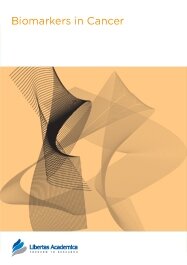

Publication Date: 28 Nov 2010
Type: Original Research
Journal: Biomarkers in Cancer
Citation: Biomarkers in Cancer 2010:2 65-78
doi: 10.4137/BIC.S6040

Background: Tumor immunology research has led to the identification of a number of tumor-associated self antigens, suggesting that most tumors trigger an immunogenic response, as is the case in osteosarcoma, where the detection of natural serum IgM antibodies might achieve the diagnosis of osteosarcoma. Natural IgM antibodies to tumor-associated proteins may expand the number of available tumor biomarkers for osteosarcoma and may be used together in a serum profile to enhance test sensitivity and specificity. Natural IgM antibodies can be consistently detected in the peripheral blood sera months to years before the tumor is diagnosed clinically. The study of the level of a potential biomarker many months (or years) prior to diagnosis is fundamentally important. Integrated circulating and imaging markers in clinical practice treating osteosarcoma have potential applications for controlling tumor angiogenesis.
Objectives: To study the expression of natural IgM antibodies to the tumor antigens of angiogenesis in the peripheral blood sera of osteosarcoma patients and healthy individuals, and to develop serum-based predictive biomarkers.
Methods: Peripheral venous blood samples were collected from 117 osteosarcoma patients and 117 patients with other tumors. All diagnosis was histologically confirmed. Staging of patients was performed according to the Enneking Surgical Staging System. The control group consisted of 117 age- and sex- matched healthy individuals. In this study, novel immunoconjugates were designed, synthesized and then used to develop a rapid, specific and sensitive enzyme-linked immunosorbent assay (ELISA) method to detect angiogenin (ANG)–IgM directly in the peripheral blood sera of humans.
Results: Serum ANG–IgM levels are significantly higher in osteosarcoma patients than in healthy individuals (P < 0.005). Serum ANG–IgM levels varied widely, but were highly dependent on the concentration of IgM (r = 0.85; P < 0.0005). We found ANG–IgM in the sera of 85% of newly diagnosed osteosarcoma patients and ANG–IgM levels were significantly higher in osteosarcoma patients compared to any other tumors (P < 0.001).
Conclusions: These results demonstrated that the combined biomarker ANG–IgM has greater sensitivity and specificity in early diagnosis of osteosarcoma patients than the traditional biomarkers (ANG and vascular endothelial growth factor). Circulating ANG–IgM immune complexes can potentially serve as a biomarker for increased risk of osteosarcoma, because relatively high serum levels were also detected in otherwise healthy individuals with a first degree family history of osteosarcoma and in patients with a diagnosis of benign conditions. Immunological aspects of angiogenesis for managing osteosarcoma will have a practical value in early diagnosis, prognosis and monitoring response to antiangiogenic therapy.
PDF (3.85 MB PDF FORMAT)
RIS citation (ENDNOTE, REFERENCE MANAGER, PROCITE, REFWORKS)
BibTex citation (BIBDESK, LATEX)
XML
PMC HTML

The editorial staff of Biomarkers in Cancer are very efficient and helpful. I am happy to work with them. I look forward to reviewing future manuscripts.
Facebook Google+ Twitter
Pinterest Tumblr YouTube